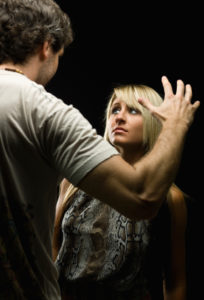The Cycle of Violence
 Domestic Violence: The Cycle of Violence
Domestic Violence: The Cycle of Violence
Many women in abusive relationships see the abuse they endure as single incidents rather than a series of incidents forming a pattern, when in fact, an abusive relationship is typically characterized by a predictable cycle. Living within this cycle of an abusive relationship will extremely deteriorate self-esteem and self-worth. The cycle of violence will occur many times in a relationship and an abuser can take from a few hours to a year or more to move through the phases. The cycle of violence will continue throughout the relationship until there is a decision for one individual to change the composition of the relationship. The woman usually is the individual that decides to change by ending the relationship. Please see below for a diagram on the Cycle of Violence.
Battering behaviour usually follows a definite cycle. Understanding this cycle is important in learning to help those in abusive relationships. The cycle of violence helps explain why she stays.
Phase One
Tension Building State
He attacks her verbally with insults, putdowns, accusations. Minor battering incidents occur. She tries to calm him, trying to anticipate his every whim. As the tension builds, she becomes more passive, he becomes more oppressive. She blames herself for not being able to control the situation; she feels helpless. Tension becomes unbearable.
Phase Two
Acute Battering Incident
Tensions that build up in Phase One erupt into violence. The incident is usually triggered by an external event or internal state of the man, rather than by the woman’s behaviour. It is during this stage that the woman is most likely to be sexually assaulted, unjured or killed.
Phase Three
Honeymoon Stage
After the acute battering incident, the man becomes extremely loving, kind and contrite. He begs forgiveness and promises it will never happen again. As their relationship deteriorates, his loving behaviour is increasingly important to her. For a time, he seems like the man she fell in love with. Guilt also holds her. They both believe she is responsible for his future welfare, or, if she leaves, for breaking up the home. If she stays, it is not long before the loving behaviour gives way to small battering incidents. A NEW CYCLE OF VIOLENCE BEGINS.
Over time, the cycle of violence shifts. Honeymoon periods become shorter, tension and violence increase. Some who work with those in abusive relationships say “indifference” sometimes becomes a phase of the cycle. Frances Woods has identified stages a battered woman goes through, as she lives within the cycle of violence over a period of time. She may need different kinds of help at different stages (Living Without Violence, 1981).
Stages in the Battered Women’s Experience
Stage One
Denial
An abused woman’s most common response to early bettering incidents is to deny there is a problem. Denial is a common human response to any traumatic experience. She may simply not be able to believe the incident happened.
If she grew up with violence, a woman may downplay the incident (“He only shoved me”) or may believe that violence is normal. If she did not grow up with violence, here image of “a battered woman” may be someone poorly educated or low income, and she does not want to perceive herself in that way. She is ashamed and does not want anyone to know. The couple probably does not discuss the incidents for fear that talking might trigger more incidents.
Stage Two
Blaming Herself
Guilt and turmoil characterize the woman’s feelings as she begins to recognize that she is battered. Three factors contribute to her blaming herself:
– Low self-esteem. Even if she started with a high level of self-confidence, being abused makes her doubt her worth. She begins to believe that she deserves the abuse.
– Others blame her. Her husband is likely to blame her (“If you’d keep the kids out of the toolbox, I wouldn’t have to get mad”); and she accepts responsibility for his actions. Widespread public opinion that “she must have asked for it,” and that women are responsible for whaqt happens in a family, reinforce that she is to blame.
– She needs to feel some power: As the situation deteriorates and she feels increasingly powerless, she can get some sense of controlling the situation if she believes she causes it. The logic goes something like this: “I must provoke him to hit me. If it’s me that makes him do it, I could stop provoking him and then he would stop hitting me. I’ll try harder.”
Stage Three
Seeking Help
Reaching for help is often a negative experience.
Friends and family may disbelieve her, or may tell her she is to blame, or that “You made your bed, lie in it.”
Women may find that police, lawyers, and the legal system are guided by rules set up to protect the civil rights of the assaulter more than the victim.
Rural women may find services do not exist. Even a woman who has access to services, may not find doctors, counsellors or other helpers with in-depth understanding of her situation. The common belief that violence in the home is a family affair may mean potential helpers do not feel they should intervene. Societal values of keeping the family together at all cost may convince her to return.
She is in a no-win situation. If she leaves, “she didn’t try.” If she stays, “she must like it.”
If a woman reaches out for help and finds none, she may be driven back to the violent relationship.
Stage Four
Going In and Out of the Relationship (Ambivalence)
Those who work with assaulted women say 80% – 90% of women leave and return to the relationship more than once. This ambivalent stage causes misunderstanding, hostility, and frustration towards the assaulted woman, and may lead potential helpers to give up on her.
During the ambivalent stage, the woman is trying to decide whether to leave or stay in the relationship. She must go back and forth to help her decide.
She may try counselling to salvage the relationship. However, few assaulting maates will attend counselling and, even if they go, counselling alone seldom stops assaulters from hitting. Counselling in combination with external control (eg. A restraining order) has sometimes made a difference.
Why does she leave? She believes her life is in danger. She fears for her children. She has some hope of supporting herself in the outside world. She has mustered enough self-confidence to believe she can have a satisfying life on her own. When she leaves, she tests if she can survive in the outside environment.
Why does she go back? She wants the relationship (she still loves him). She believes his promises or his threats. She feels guilt;;y; about breaking up the family. She feels worthless and fears she can’t make it on her own. When she goes back, she tests if the relationship can be changed. She needs to be sure she’s given it every chance.
Though nearly all assaulted women go through the pattern of ambivalence, each does so in her own way. She may leave and return few or many times; she may come to a resolution gradually or suddenly. The ambivalent stage may last for years.
Stage Five
Living Without Violence
Whether she stays or leaves, the woman will probably need on-going support. Fear, low self-esteem and flash-backs of the violence may plague her. Some say it takes five years to recover from a violent relationship. Some say it takes forever.
From: Breaking the Pattern: How Alberta Communities Can Help Assaulted Women and Their Families, Alberta, Social Services and Community Health (1985).
Signs that You are in an Abusive Relationship
Are you examining your relationship and wondering if what you are going through is abuse? Below is a quick checklist of some of the abusive behaviours that you may be enduring.
| ISOLATION Restricting Freedoms:
|
ECONOMIC ABUSE
|
MALE PRIVILEGE
|
SEXUAL ABUSE
|
| THREATS AND PSYCHOLOGICAL ABUSE Threats to:
|
| ANGER AND INTIMIDATION By:
|
PHYSICAL ABUSE
|
EMOTIONAL ABUSE
|
After reviewing this quick checklist, how many of these points apply to you? Did you say “yes, that happens to me!” or “yes, my spouse does that!”? These are all “relationship red-flags”, you should take a closer look at your relationship if any of these apply to you.
If you have answered “yes” to any of the points above, it may be a good idea to speak with a counsellor about your situation.
Barbara is here to help, is non-judgmental, and will NOT force you to leave your partner. She will simply discuss your situation with you. What you disclose is your choice. She will discuss your options with you, and make a safety plan with you to help you protect yourself (and your children). Living in an abusive relationship is exhausting. The feeling of walking on egg-shells, never doing anything right, and having your power taken from you by a person who will go to hurtful lengths to control you, can clutter your brain and make it hard for you to sort out “first steps” or even tackle everyday issues. YOU DON’T HAVE TO DO IT ALONE!
604 860 0507


